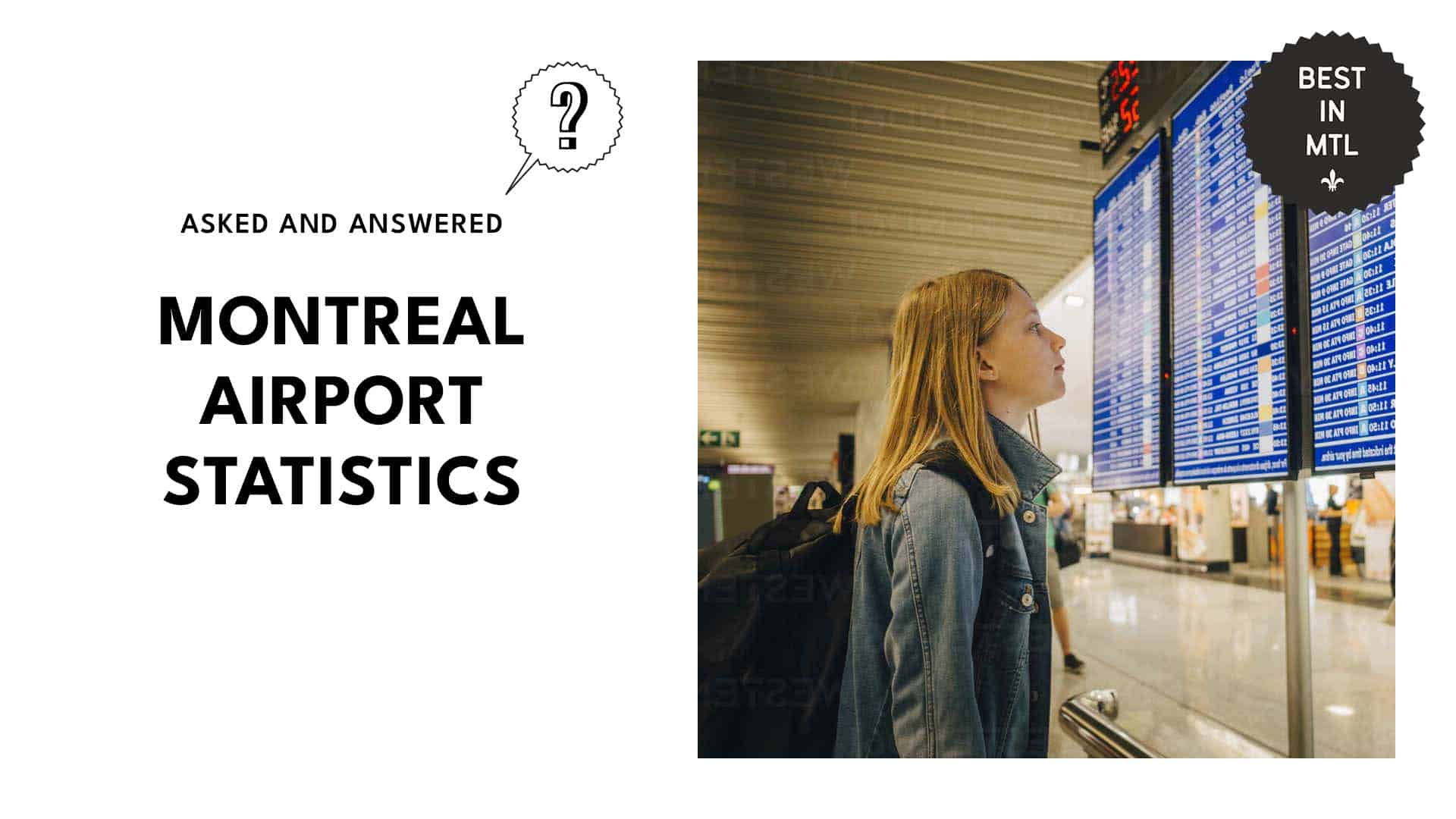Understanding Montreal’s air traffic statistics and trends: A data-driven analysis
Key Insights
| According to Statistics Canada, passenger traffic at Montreal Airport dropped from 19,578,357 in 2019 to 5,178.197 in 2020. It rebounded to 20,380,075 in 2023, surpassing pre-pandemic passenger traffic. According to Aéroports de Montréal, both YUL and YMX airports operate 24/7 and are key cargo hubs. YUL specializes in global freight, while YMZ handles oversized shipments and industrial logistics. According to Statistics Canada, Montreal Airport is among the busiest of all Canadian airports. The airport ranks behind Toronto airport with 43.7 million passenger traffic and Vancouver with 24.2 million passenger traffic in 2023. |
According to Statistics Canada, Montréal/Pierre Elliott Trudeau International Airport recorded 19,578,357 passengers in 2019. This figure drastically declined to 5,178,197 in 2020.
Passenger volumes remained relatively static in 2021 until a substantial recovery in 2022. By 2023, the airport had fully surpassed pre-pandemic levels, recording 20,380,075 passengers.
To provide you a clear picture of the traffic in Montreal Airport, the following chart illustrates the breakdown of the air passenger traffic in the airport from 2019 to 2023.
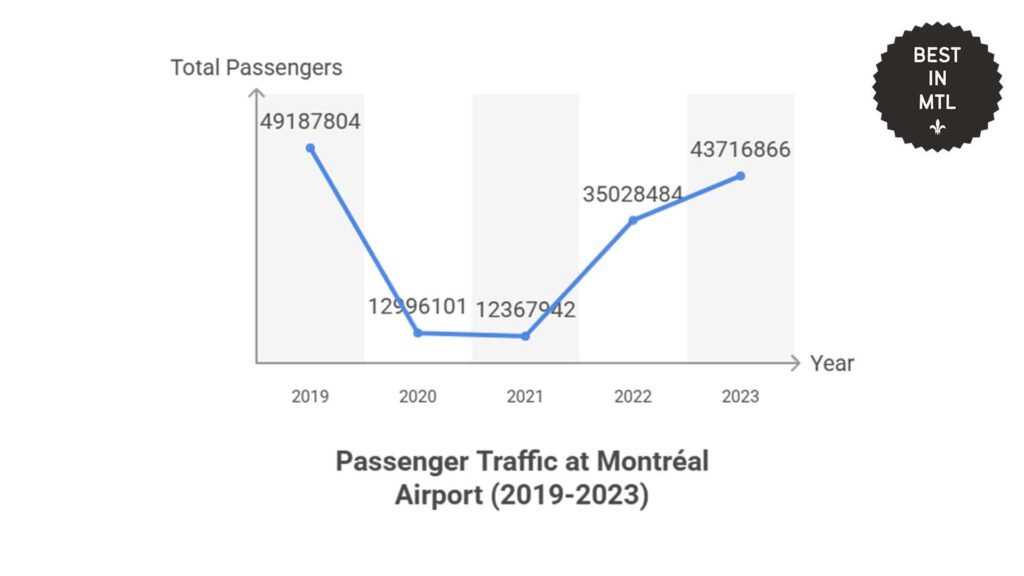
According to Statistics Canada, domestic traffic stood at 6,895,629 passengers in 2019 and then fell sharply to 1,930,808 in 2020. It then rose modestly to 2,322,156 in 2021 and began experiencing a more robust recovery in 2022.
By 2023, domestic traffic recorded 6,212,932 passengers, nearly restoring pre-pandemic levels.
Transborder traffic, which includes traffic between Canada and the United States, saw a notable decline from 4,442,248 passengers in 2019 to just 1,032,052 in 2020.
A further drop to 842,055 occurred in 2021, representing the lowest point in five years. Volumes increased substantially to 3,407,407 in 2022 and rose again to 4,636,159 in 2023.
International traffic (excluding the US) also reflected significant fluctuations. Passenger traffic declined from 8,249,480 in 2019 to 2,215,337 in 2020. It was then followed by a slight dip to 1,843,890 in 2021.
However, this traffic experienced a rapid recovery in subsequent years, reaching 6,931,001 in 2022 and increasing further to 9,530,984 in 2023.
Comparison to other Canadian airports
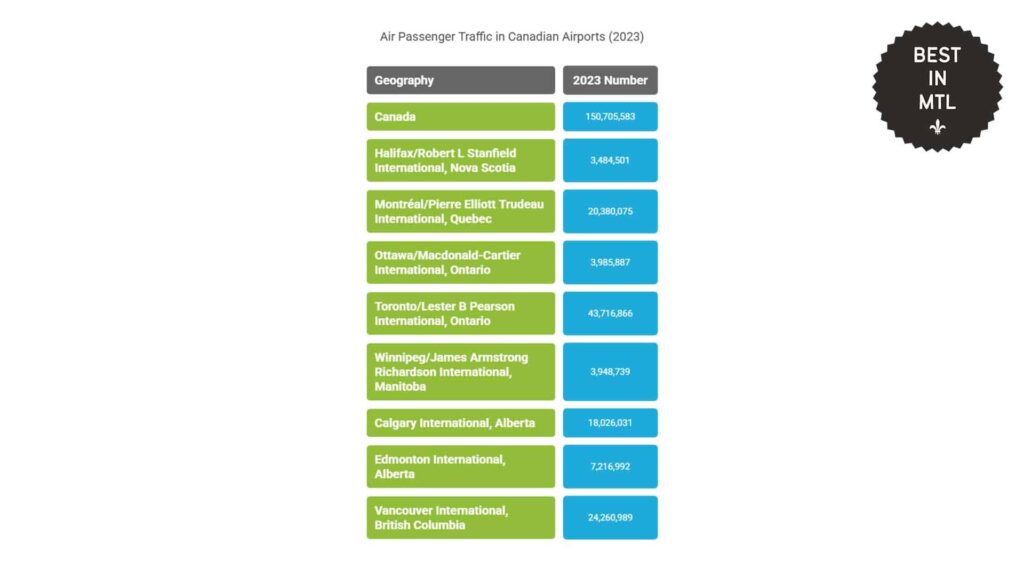
Montréal Trudeau International Airport supports a substantial number of passengers each year. In 2023, Montreal saw a total of 20,380,075 passengers, according to Statistics Canada. This makes it one of the busiest airports in Canada.
This volume of traffic places it in the middle tier when compared to other major Canadian airports.
Toronto/Lester B. Pearson International Airport
Toronto/Lester B. Pearson International Airport (YYZ) consistently leads in passenger traffic among Canadian airports, handling a staggering 43,716,866 passengers in 2023. This is nearly double the traffic seen at Montreal’s airport.
Vancouver International Airport
Vancouver International Airport (YVR) also ranks highly in passenger traffic, with a total of 24,260,989 passengers in 2023. While this is still a considerable number, it is under the total of Toronto’s airport and slightly higher than Montreal’s airport.
Other major Canadian airports
In comparison, Montreal is far ahead of several other Canadian airports in terms of passenger traffic.
For reference, Calgary International Airport (YYC) had 18,026,031 passengers in 2023, while Edmonton International (YEG) had 7,216,992 passengers in the same year. Winnipeg’s James Armstrong Richardson International (YWG) had 3,948,739 passengers in 2023.
The volume of passengers at these airports is notably fewer than those at Montreal’s airport.
Smaller Canadian airports
Smaller Canadian airports like Halifax/Robert L. Stanfield International (YHZ) and Ottawa/Macdonald-Cartier International (YOW) have fewer passengers.
YHZ handled 3,484,501 passengers in 2023, while YOW handled 3,985,887 passengers in the same year.
Flight operations and airlines in Montreal
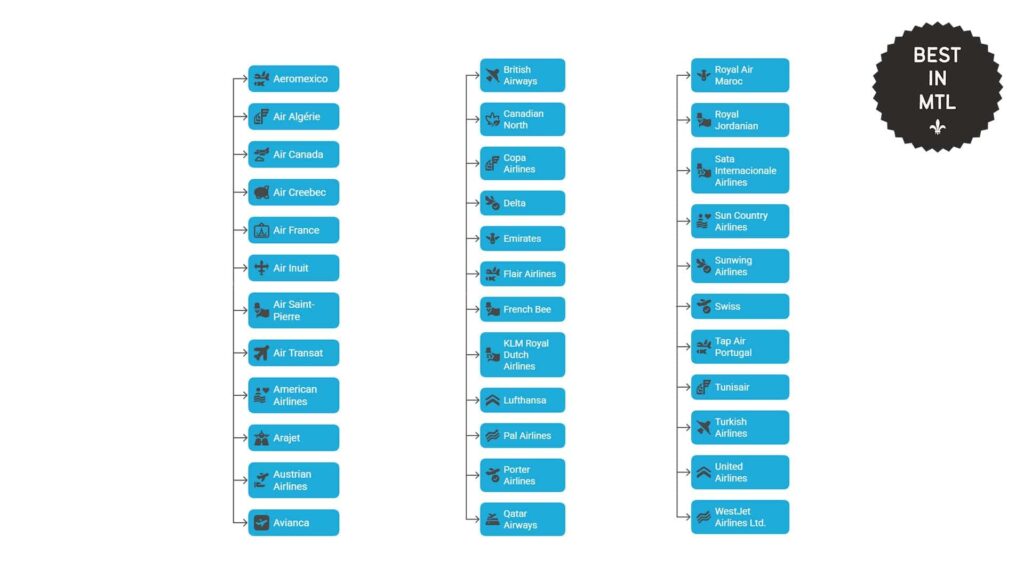
The city’s airport, Montréal Trudeau International Airport, hosts a diverse range of airlines offering international and domestic flights.
Key international carriers include Air France, Lufthansa, and Emirates. Additionally, regional airlines like Air Creebec and Air Inuit serve the northern parts of Canada.
For transborder travel, there are major American carriers, including American Airlines, Delta, and United Airlines. In addition, Montreal’s airport supports emerging airlines such as Arajet and French Bee.
Low-cost carriers like Flair Airlines and Sunwing Airlines also provide affordable options for those seeking budget-friendly flights.
Cargo and traffic operations in Montreal
Montreal’s strategic location makes it a key gateway to the Americas.
According to Aéroports de Montréal, both Montréal Trudeau International Airport (YUL) and YMX International Aerocity of Mirabel are well-equipped to handle cargo operations 24/7.
Cargo transport at YUL
YUL handles significant air cargo operations with specialized infrastructure and services. The airport boasts a range of warehouses under customs control, including refrigerated storage for perishable goods.
With direct flights to over 157 destinations and a network of cargo service providers, YUP is a major player in Montreal’s global cargo transport.
Cargo transport at YMX
YMX operates 24/7 without any operational restrictions. The airport is well-equipped to manage heavy and oversized shipments, providing various services such as ramp handling, de-icing, refueling, and specialized live animal transport management.
Its land area of 4.5 million square meters supports the airport’s capacity for large-scale industrial and logistics operations.
Sustainability and environmental initiatives by Montreal airports
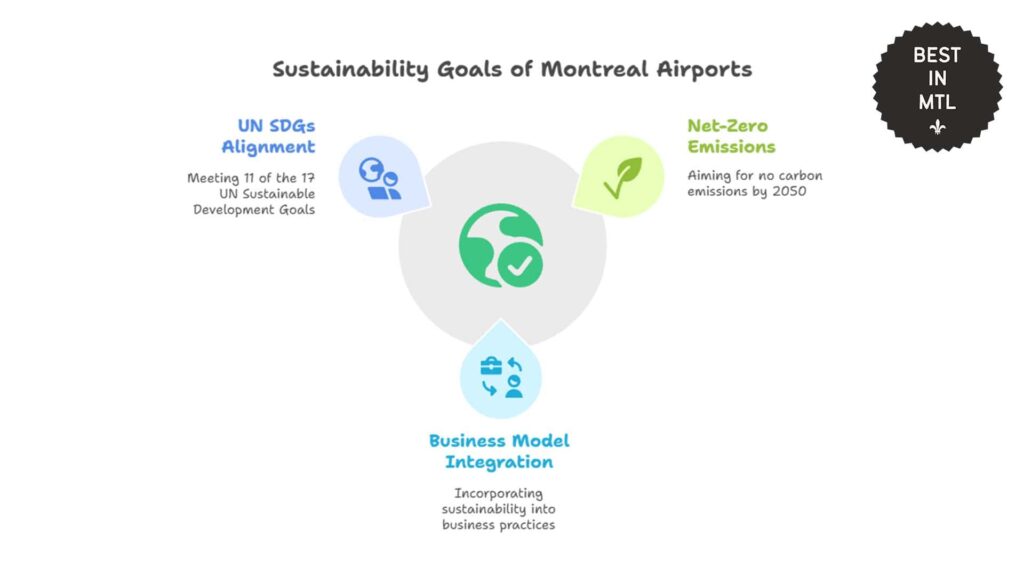
Montreal has commitments for sustainability, particularly in aviation. For example, Airports Council International (ACI) World has launched a Sustainability Expansion Plan.
This initiative aims to enhance airport sustainability worldwide, aligning with the United Nations 2030 Agenda for Sustainable Development. This plan is part of a broader commitment to achieving net-zero carbon emissions by 2050.
ACI partners with the Government of Canada, the Government of Quebec, and the City of Montreal for this project.
Aéroports de Montréal (ADM)
Aéroports de Montréal’s (ADM) commitment to sustainability is outlined in its Sustainability Plan 1.0 published in 2023. The plan was developed with input from a sustainability committee, which includes managers from various ADM departments.
This committee helps integrate sustainability into ADM’s business model and practices.
Montreal Metropolitan Airport (MET)
Montreal Metropolitan Airport (MET) has taken steps to integrate environmentally friendly practices into its operations. Its sustainability plan is centered on reducing greenhouse gas (GHG) emissions, with a focus on Scope 1,2, and 3 emissions.
MET aims to meet 11 out of the 17 Sustainable Development Goals (SDGs) of the United Nations.
Travel tips for passengers using Montreal airports
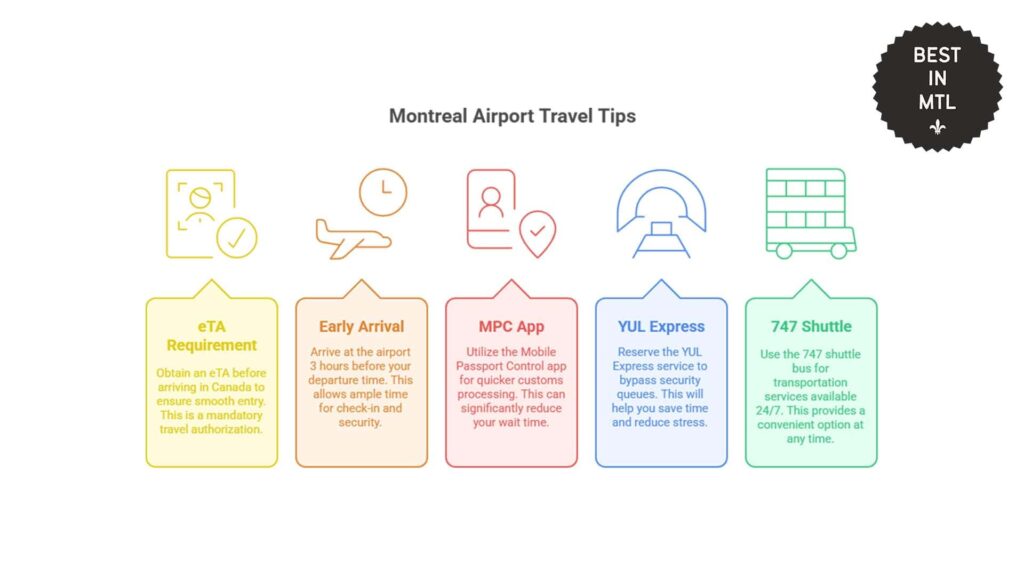
For those traveling to Canada using the Montreal Airport, Tourisme Montreal has laid out key things to keep in mind.
- For international arrivals, getting an Electronic Travel Authorization (eTA) is required to enter Canada (except for US citizens and Canadian visa holders). Passengers must go through the Canada Border Services Agency (CBSA).
- For domestic arrivals, simply follow the signs to the baggage claim or the exit for a seamless process.
- For passengers departing Montreal, it’s best to arrive 3 hours early to allow enough time for security. Passengers can use the Mobile Passport Control (MPC) app to speed up the customs clearance process, and booking a YUL express service can speed up the security check.
- There is a 747 shuttle service at the airport that offers 24-hour service. It’s best to buy a ticket in advance at vending machines, in the international arrivals area, or at any of the metro stations downtown.
- For transit flights, it’s best to book a room at the Montreal Airport Marriott In-Terminal Hotel, which is located next to the USA departures terminal.
References
- Aéroports de Montréal. Cargo transport (n.d.). https://www.admtl.com/en-CA/corporate/commercial-partnerships/air-services/cargo
- Aéroports de Montréal. Sustainability (n.d.). https://www.admtl.com/en-CA/community/environment-and-sustainability/sustainability
- Airports Council International (ACI) World. ACI World launches the Sustainability Expansion Plan in Montréal (2023). https://aci.aero/2023/05/05/aci-world-launches-the-sustainability-expansion-plan/
- Montréal Trudeau International Airport. Airline directory (n.d.). https://www.admtl.com/en-CA/flights/airlines
- Montreal Metropolitan Airport. Environment (n.d.). https://metmtl.com/en/environment/
- Statistics Canada. Air passenger traffic at Canadian airports, annual (2024). https://www150.statcan.gc.ca/t1/tbl1/en/tv.action?pid=2310025301
- Tourisme Montreal. The ultimate guide to the YUL Montréal-Trudeau International Airport (2024). https://www.mtl.org/en/experience/airport-yul-guide







